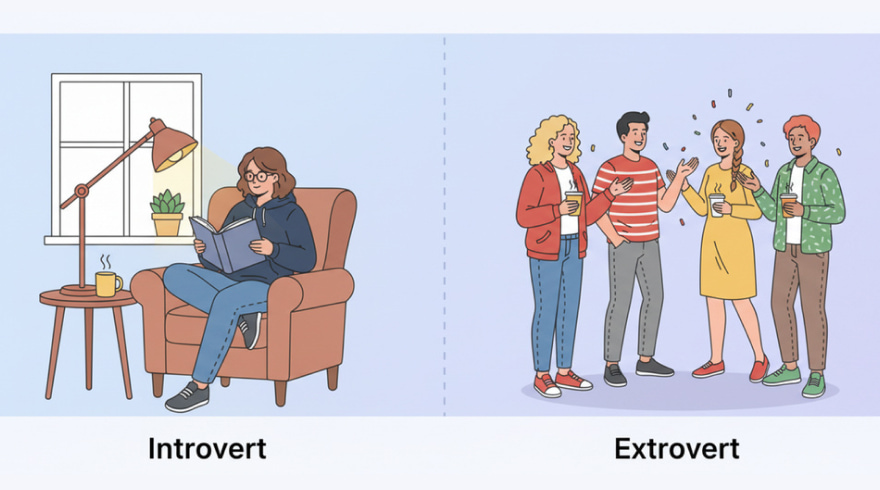Introverts, Extroverts, and Ambiverts: A Complete Guide to Personality Energy

Understanding the Social Energy Spectrum and Why It Matters
Personality isn’t a rigid box; it is a fluid continuum shaped by biology, context, and habits. Some people replenish their energy in solitude, others thrive around people, and many oscillate between these modes depending on the situation. Appreciating this spectrum helps you choose environments that nourish focus, calm, curiosity, and courage. When you align your day with your energy patterns, you lower burnout, heighten creativity, and increase the odds of meaningful connection.
People often navigate labels while exploring work style, friendships, and recovery time after stimulation, and many turn to the introvert extrovert ambivert framework to make sense of those patterns. Instead of treating one mode as “better,” it’s wiser to treat each as a set of advantages that shine under different conditions. When you notice how you perk up during dialogue or during quiet reflection, you can select the environment that plays to your strengths rather than fighting your wiring.
Curiosity about identity naturally leads to tools that encourage introspection, and some readers like the conversational format of the am i an introvert ambivert or extrovert quiz for a quick snapshot. While no quiz can define the whole of you, well-designed questions reveal tendencies such as sensitivity to noise, preference for depth versus breadth in conversations, and tolerance for rapid task-switching. Using these insights, you can craft routines that support sustained momentum without sacrificing wellbeing.
- Energy source: solitary restoration, social stimulation, or situational mix
- Interaction cadence: measured dialogue, lively exchange, or adaptive pacing
- Focus style: deep single-tasking, collaborative brainstorming, or flexible blending
The Science of Traits, Assessments, and Everyday Clues
Behind the labels sit measurable tendencies such as sensory processing sensitivity, arousal thresholds, dopamine reward response, and circadian preferences. Research suggests that environment fit, noise level, schedule density, and social expectations, strongly influences performance and stress. When context aligns with temperament, people experience flow, and when it clashes, they experience friction. Sustainable success often comes from adjusting dials rather than forcing wholesale transformation.
Short diagnostic tools are popular, and many people consult an introvert extrovert ambivert test to illuminate patterns like recovery speed after meetings or comfort with spontaneous conversation. While not clinical instruments, these checklists can prompt useful reflection about how you handle brainstorming, deadlines, and downtime. Paired with journaling, they help translate self-knowledge into calendar choices, meeting formats, and communication rhythms that feel natural.
Some assessments compare tendencies across contexts, and a comprehensive introvert ambivert extrovert test might examine preferences at work, at home, and in learning environments. Looking across domains matters because people shift behavior when incentives, stakes, or group norms change. A person who speaks softly in large groups may be animated in a small team, so the goal is not to pin a permanent label but to map situations that unlock your best.
| Dimension | Introvert-Leaning | Ambivert-Leaning | Extrovert-Leaning |
|---|---|---|---|
| Energy Recovery | Solitude restores | Context-dependent | Social contact restores |
| Communication | Thinks, then speaks | Adapts to group | Speaks to think |
| Work Mode | Deep focus blocks | Blended cycles | Collaborative bursts |
| Stimulation | Prefers low noise | Moderate tolerance | Seeks lively settings |
| Networking | Few deep ties | Depth and breadth | Many broad ties |
- Keep a weekly energy log to see what drains or fuels you.
- Experiment with meeting sizes and formats to observe performance shifts.
- Adjust recovery windows after high-stimulation tasks.
Comparisons, Misconceptions, and Contextual Flexibility
Public narratives often polarize personalities, but the data tell a subtler story. Your social energy can vary by task importance, stakes, and group dynamics, and it evolves with experience. Clinging to rigid labels can limit growth, especially if you assume certain roles “belong” only to people with a specific energy pattern. Instead, identify the conditions under which you thrive and replicate them intentionally.
Many guides try to score differences, yet the real value is recognizing how introvert vs extrovert vs ambivert dynamics manifest in daily choices such as scheduling, collaboration, and recuperation. In practice, optimizing your week might mean batching meetings, creating quiet focus corridors, or designing hybrid brainstorms where ideas are submitted in writing before live discussion. This diversity of methods accommodates different cadences without sacrificing momentum.
Language shapes expectations, and workplace clichés sometimes oversell charisma while overlooking preparation, strategy, and listening. A more balanced lens considers how extrovert vs introvert vs ambivert tendencies contribute complementary strengths to the same project. For instance, discovery interviews can benefit from a lively opener, a precise set of follow-ups, and a reflective synthesis afterward. Teams that normalize these handoffs reduce bottlenecks and improve outcomes.
- Misconception: Quiet equals disengaged. Reality: Deep processing often appears calm.
- Misconception: Talkative equals unfocused. Reality: Verbal ideation can surface breakthroughs.
- Misconception: Mixed style equals indecisive. Reality: Situational agility is a strategic asset.
Benefits and Strengths: Turning Temperament Into an Advantage
Every position on the spectrum confers unique benefits when matched to the right context. People who savor depth often excel at complex problem-solving, risk assessment, and long-form creation. Those who draw power from interaction can catalyze momentum, build coalitions, and handle rapid-fire coordination. Individuals who flex between modes frequently bridge gaps, translating needs across groups and smoothing collaboration.
Exploration tools can nudge self-awareness, and some readers enjoy the reflective style of an introvert extrovert ambivert quiz to reveal patterns they hadn’t noticed. Whether you favor solo sprints or collaborative jams, the secret is designing cycles that protect recovery and leverage prime hours. You can combine quiet mornings for craft with afternoon sessions for outreach and feedback to sustain both quality and visibility.
Community builders appreciate options that spotlight adaptability, and a concise ambivert quiz can highlight when to dial up exuberance versus when to anchor into calm. Over time, these micro-adjustments compound into trust, reliability, and consistent output. By tracking which tasks blossom under each state, you turn temperament into a strategy rather than a static identity.
- Map your peak hours to high-impact work.
- Pair complementary partners for idea-generation and refinement.
- Use recovery rituals to reset after stimulation highs or lows.
Practical Routines for Work, School, and Relationships
Life design starts with observation, not judgment. Keep a simple diary of tasks, environments, and energy before and after each block. You’ll quickly notice patterns that suggest which meetings to accept, which to decline, and which to convert into asynchronous exchanges. In relationships, you can negotiate signals for “quiet time” or “connection time” and agree on recovery practices after big events.
Self-inquiry can be playful, and some people find the question prompts in an am i introvert extrovert or ambivert quiz helpful for choosing routines that fit their social bandwidth. A plan might include two deep-focus blocks per day, a single collaborative window, and a nonnegotiable cooldown ritual. Negotiating these boundaries openly tends to reduce conflict and misunderstanding.
Team charters benefit from clarity about roles, and cross-functional work hums when groups accommodate introvert ambivert extrovert rhythms with a mix of pre-work, live sessions, and written follow-ups. In education, students gain by mixing solo study with peer teaching, while in families, a shared calendar that marks high-stimulation days prevents overload. Consistency beats intensity when building a sustainable cadence.
- Bundle social tasks together and buffer them with rest.
- Use agendas for meetings and invite written input beforehand.
- Create quiet corners and lively zones to fit multiple preferences.
From Insight to Action: Growth, Skills, and Next Steps
Understanding your energy style unlocks targeted practice. You can strengthen complementary skills without abandoning your core preferences by using gradual exposure, scaffolding, and reflective debriefs. For example, a person who loves one-on-one dialogue might stretch into small-group facilitation before tackling a large-room presentation, collecting feedback and iterating along the way.
Some readers prefer a narrative reflection, and the inner dialogue sparked by asking am i introvert extrovert or ambivert can guide which experiments to try first. Set one weekly micro-challenge, such as hosting a short standing meeting or protecting a focus hour, and evaluate the impact on energy and results. Small, repeatable wins accumulate into durable confidence.
Others favor data-driven prompts, and a focused ambivert test can reveal how context cues influence behavior shifts. With that information, you can craft playbooks for high-stakes days, including recovery plans, communication templates, and environment tweaks. Over months, your routines start to feel like second nature, providing stability even as responsibilities grow.
- Build skills adjacent to your strengths to avoid burnout.
- Schedule debriefs after major events to capture lessons quickly.
- Design rituals that reset attention, mood, and posture.
FAQ: Common Questions About Personality Energy
What is the core difference between social energy styles?
The core difference is where you gain and drain energy. Some people refuel alone, others refuel with people, and many adjust based on context. These preferences influence planning, communication, and recovery after events. None is inherently superior; the fit between environment and task determines performance and ease.
Can a person switch styles over time?
Behavior can shift with role demands, confidence, and skills, while underlying sensitivities remain relatively stable. You can train complementary abilities through deliberate practice, which expands your range without forcing you to live permanently outside your comfort zone. Think of it as building a larger toolset rather than replacing your core toolkit.
How do I collaborate effectively across different energy needs?
Blend formats: circulate agendas in advance, gather written input, then hold a concise live discussion with clear decisions and follow-ups. Offer quiet workspace options and social touchpoints. This hybrid approach respects deep focus and energetic exchange, improving inclusion, clarity, and project velocity.
What if my workplace favors one style?
Advocate for evidence-based practices that help everyone: focus hours, optional cameras, asynchronous updates, and meeting-free blocks. Share data on productivity and burnout to support experiments. Often, small process changes deliver big gains without disrupting culture, which makes buy-in easier.
How do I choose development goals that fit my temperament?
Start with outcomes you care about, then pick methods that are energizing or neutral rather than draining. If public speaking is vital, begin with small rooms and strong preparation. If deep work is vital, negotiate protected time and measure results to prove the value of those boundaries.
Latest News



